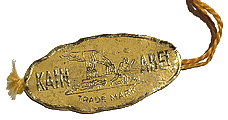About the year 1908, Emil Broch had already founded his first razor grinding company. His partner was August Woop (pronounced not the English way, but “Vop”, with a long-drawn ‘O’), and accordingly they gave the new company the name Broch & Woop. August Woop was listed as a commercial agent in old address books, which is why, as with Emil’s later cooperation with his son Willy, it seems to have been a forger/merchant partnership.
The company was first mentioned in the address book of 1909. The company’s head office has been noted as “Schaafenmühle” in Höhscheid (later a part of Solingen). Emil Broch still lived at his parents’ house at the address 3 Schaafenmühle around that time, but the given location was probably more related to the nearby Schaafenmühle grinding mill. After the fire of 1908, it had just been rebuilt by their owners Emil and Hugo Broch. They had rebuilt the old building in brick masonry, and had also built a new wooden water wheel with a diameter of three metres.
In addition to Emil and (maybe) Hugo Broch, possible grinders for Broch & Woop may have been Edmund Stamm, Paul Wagner, Heinrich Waldeier, Wilhelm Göbel, and Hugo Hardt – all proven grinders who lived in the immediate vicinity of the Schaafenmühle Kotten. Edmund Stamm even lived in the same house as the Broch family on Schaafenmühle, in 1905.
Emil Broch and August Woop led the company up to about 1912. After that, they sold it to Wilhelm, Otto, Oswald and Alex Plümacher. At the time, this family was already the owner of the Solingen knife factory Kamphausen & Plümacher, which had existed since 1861. The Plümacher family led the Company Broch & Woop about another 14 years on the address Mittelstraße (where Kamphausen & Plümacher was also based), before they merged it with their existing, larger company. (At the time of acquisition of Broch & Woop, the company of Kamphausen & Plümacher GmbH was first entered in the commercial register. In the year 1971, it was converted into an open trading company, and finally closed in 1986. It was deleted from the register in 1990.)
The address book of 1925 was the only one at all to list both Emil Broch’s former company (led by the Plumacher family) and his newly founded one at the same time (see picture).
The brand Water Wheel
Starting from 1908, the company Broch & Woop was initially run as a pure razor grinding factory. This work was easy to accomplish in the Schaafenmühle grinding mill. However, in the year 1911 Emil Broch and August Woop registered the trade mark “Water Wheel”. Obviously, they did not want to continue to restrict themselves to the sole grinding of razor blades, but wanted to go into production themselves. The new water wheel of the Schaafenmühle mill was very probably the model for the water wheel shown in the figurative mark.
Initially, Broch & Woop didn’t seem to forge the Blades of the Water Wheel razors themselves, but bought them through wholesalers. An indication of this is the existence of a razor, depicting a large eagle with the lettering “The Improved Eagle Razor” on it’s blade. On the tang of that razor, the big Water Wheel figurative mark can be seen. In my search for further specimens of this razor, however, I came across a lot of similar razors, all of which had the same blade, but named different brands on the tangs. Many of these brands appear to have been pure import marks for the American market, such as Imperial Razor, Garland Cutlery, Lion Brand, Westfield Manufacturing, Dixon Cutlery, Geneva Cutlery, Liberty Cutlery, or Oxford Razor. The Water Wheel copy seems to have been one of the few exceptions that came from a real-existing manufactory.*
From time to time you can still find old straight razors of the brand Water Wheel in online auctions and internet forum entries. However, the trade mark was sold to the Plümacher Family along with the company in 1912. Therefore, regarding razors of this brand, it will never be possible to fully clarify whether they actually originate from the production of Emil Broch. In fact, razors of this brand may even come from three different periods:
- from the production of Emil Broch and August Woop, as Broch & Woop (1911 – 1912),
- from the production of the Plümacher family, under the company name of Broch & Woop (1912 – 1926), or
- from the production of the company Kamphausen & Plümacher (after 1926).
Addendum: As I have found out recently, this list can probably be further limited, as the company Kamphausen & Plümacher has additionally provided their Water Wheel straight razors with the mark “Kamphausen Plumacher Germany” on the back of the tang. A razor without this marking would therefore likely come from one of the two first-mentioned periods.
In any case, it should be considered as secured that Emil Broch not only produced razors under the brands »Kain-Abel«, »Elsine«, and »Bromeso«, but also under the brand »Water Wheel«.
* Another exception was an “Improved Eagle Razor” by the renowned Solingen manufacturer Alexander Coppel, whose successor company is still known for the brand Alcoso.
| Brand | Edition | Model | Remarks | Handle materials | Blade steel | Blade width | Blade pattern | Blade engraving | Tang front | Tang back |
|---|---|---|---|---|---|---|---|---|---|---|
| Water Wheel | The Improved Eagle Razor | Blade (or complete) from wholesalers? | 1. Bone (?) 2. Steel (?) | ? | 9/16" | Eagle | The Improved Eagle Razor | Water Wheel | Germany | |
| Water Wheel | The King George Razor | Model 497 | Blade (or complete) from wholesalers? | Wood (?) | ? | ? | King George | The King George Half-A-Crown Razor | Water Wheel | ? |
| Water Wheel | Silver Steel | Ivory | Silver Steel | 5/8 | - | - | Water Wheel | Silver Steel |

